The line requires a footprint of some 400m2 and will occupy a large part of anew extension to the customer's assembly building. It will be used to fill high value products manufactured using complex biotechnological processes, such as hormone preparations and anticancer drugs.
Four different vial sizes - 3, 5, 10 and 20 ml - can be accommodated using the same carriers in the filling area, reducing changeover times.
The first step in the production line is the cleaning of the vials. Supplied in bulk, the vials reach the cleaning unit on a conveyor belt, which is loaded in a separate room located upstream using two unwrapping units. The interior and exterior of the vials are sprayed and rinsed with various cleaning media at six stations as they are conveyed continuously through the machine.
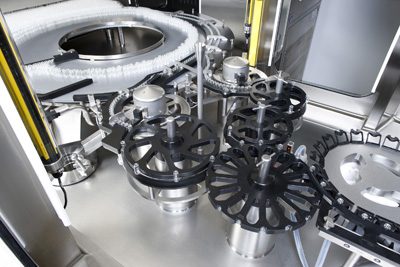
Transfer of the sterilised vials to the individual transport system of the filling and closing machine
The cleaned containers are transferred directly from the rinsing machine to the conveyor belt of the sterilising tunnel. The equipment monitoring the supply of containers at the infeed to the tunnel ensures that the containers are fed smoothly into the tunnel and controls the synchronisation with the machines located upstream and downstream. As the vials are conveyed through the tunnel they are sterilised and depyrogenised.
The tunnel is divided into three zones. In the first zone the vials are warmed, in the second they are sterilised and in the third they are cooled to the temperature required for the filling process in the subsequent aseptic filling area. At the tunnel exit the vials are buffered and unscrambled on a rotary table optimised for the laminar air flow. From there they enter the filling and closing machine where they are conveyed individually.
The filling and closing machine is equipped with two dosing stations, and processes 12 containers per cycle in a continuous motion. The product is metered either with twelve valveless rotary piston pumps or with a time/pressure dosing system. In this way the customer can select the most suitable dosing method for the product to be filled.
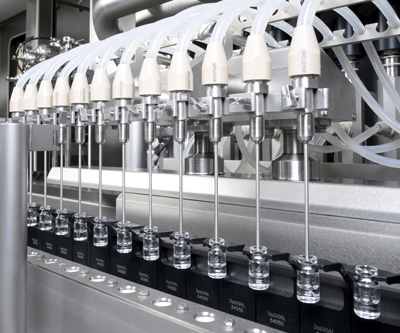
Dosing station with 12 working positions
The preferred method for biotechnology products with long molecular chains is the time/dosing method, which is particularly gentle for the product. For products requiring high dosing accuracy the rotary piston pumps are preferred.
To optimise efficiency even when small batches of different products are run, the time/pressure dosing system is installed in duplicate; while one is in production the other can be cleaned, sterilised and prepared for the next run.
When changing from one batch or product to the next, all components that come into contact with the product can be cleaned and sterilised using the integrated CIP/SIP system, avoiding the need to remove and reinstall the parts. The program-controlled process runs the dosing needles automatically into the CIP/SIP receptacle. The machine moves to all further dosing system positions required during the cleaning and sterilising process when prompted. The process is monitored and documented.
The In-Process Control (IPC) constantly monitors the dose dispensed. Two electronically controlled precision scales determine the exact quantity dispensed by determining the tare weight - prior to dosing - and the gross weight - after the dosing process. For this purpose a container is taken out of the transport system without interrupting production and returned to the transport system for the filling process after determining the tare weight. Immediately after dosing has been completed, the gross weight of this vial is determined in the same way.
The net weight then calculated is the basis for the electronic feedback adjustment, which can make any necessary correction to the dose dispensed to ensure the required quantity is always metered. Documentation with statistical evaluation is drawn up using all the containers checked by the IPC. The IPC system runs on this line with a 4% check quota without a reduction to the production output of 600 vials per minute.
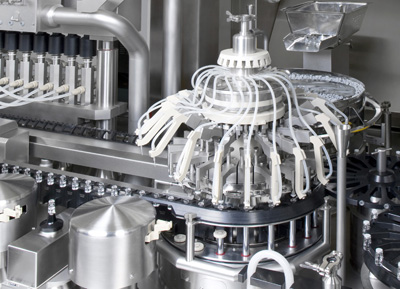
Rubber stopper insertion station with gas-flushing to reduce the residual oxygen in the vial to < 2%
After filling, the vials are closed with rubber stoppers by a continuous motion stopper insertion unit. Immediately beforehand, and during the closing process, the vial interior is flushed with gas. The stoppers are supplied by a combination of supply bin and sorting bowl thereby ensuring that the right quantity of stoppers is available to suit the machine output. Particle generation is very low - an important aspect in the aseptic work area.
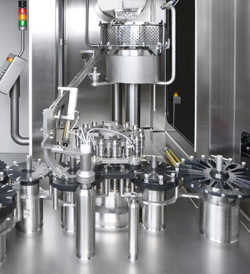
Crimping machine for continuous overcapping with flip-off caps
The containers are held individually by suction in the star wheels conveying them to the crimping machine. As the vials pass beneath the cap transfer track each pulls a cap out of the track. This cap is then crimped firmly to the vial neck in a continuous motion as the vials are conveyed through the machine. The cap application pressure is monitored permanently.
The vials are then conveyed individually to the printing and inspection machine. Either the side or the top of the flip-off cap can be printed, thereby providing each vial with a unique identification. The crimping quality and the print on the cap are then checked by a vision system. As the vials have been conveyed individually at every working step since the infeed to the filling and closing machine, each individual vial of a batch can be traced.
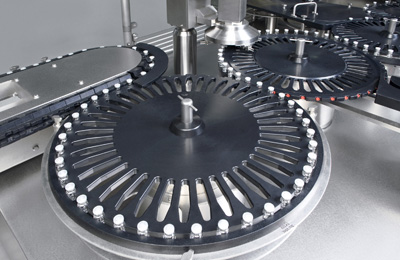
Printing and inspection machine
The final step in the production line is the loading of the vials into trays. To meet the high output of the filling and closing machine, the line has two tray-loading units. A camera monitors the loading in orderly rows of precise quantities. These trays are then used to load the machines carrying out the secondary packaging operations.
The sterility of the product to be filled is guaranteed by the isolator that encloses the filling and closing stations in a cleanroom area. Consumables such as stoppers are brought into the isolator via transfer ports that do not impair sterility (Alpha-Beta ports). Auxiliary material such as tools and Petri dishes, are introduced into the isolator via a separate material lock. Sleeve and glove assemblies permit manual intervention in the aseptic area without compromising sterility.
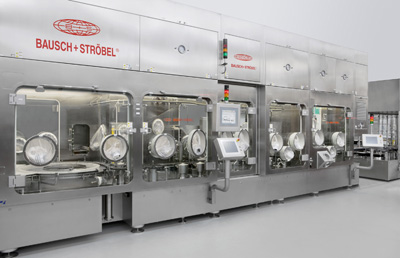
The sterility of the product to be filled is guaranteed by the isolator
Throughout the complete line the vials are monitored by a multitude of checking stations as well as the above-mentioned IPC (In-Process Control). In this way safe and reliable pharmaceutical processing is monitored and controlled throughout production. The machine data logging system saves and documents all the production data including all fault messages and operator interventions.
Operating the individual machines or the entire production line is carried out from graphical operating panels with menu navigation. All the production parameters and data, operator prompts and fault messages can be called up on the touch screen and are displayed in plain text.
